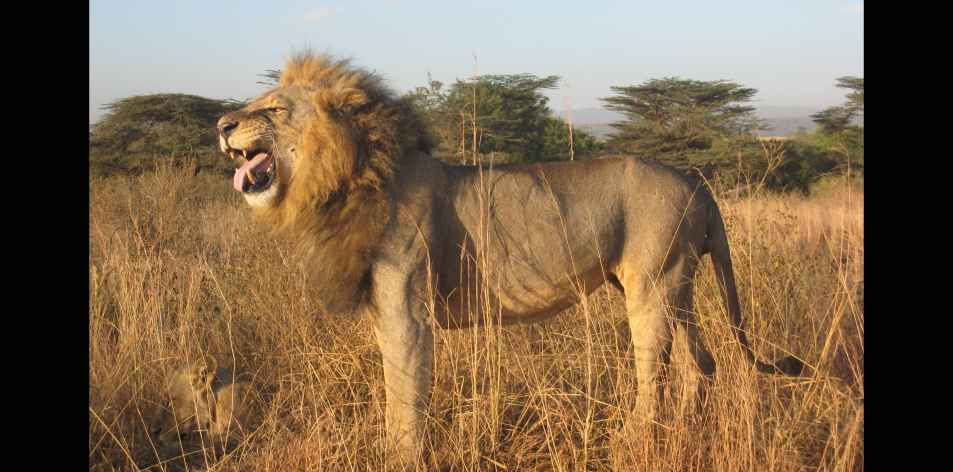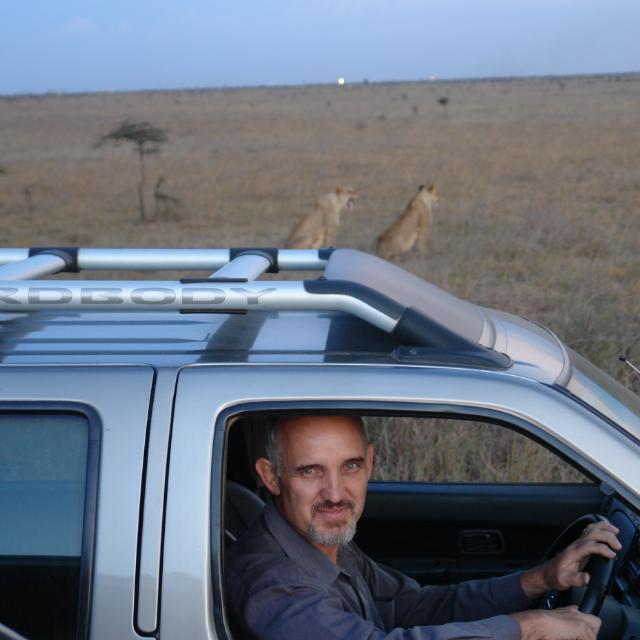
Big Cat Communication!! – Article by Gareth Jones
NAIROBI NATIONAL PARK – BIG CAT COMMUNICATION!! – By GARETH JONES
Late one afternoon I sat quietly in the Langata forest watching a sleeping lion in the hope that he would awaken from his slumber and possibly be active in some way. Well about an hour later his majesty did decide to awaken, he then stood up and gave a very powerful, awesome roar. Considering he was only metres away from me the sound was extremely loaded and the ground even seemingly vibrated. In the park, this prime lion is also known as Sam, his brother known as Cheru then called back nearby, they are about 14 years old. Soon their dominant calling roar will be replaced by the stronger young lions as they take over the territory.
Of the big cats, it is lions (Panthera leo) that have the most complex communication methods due to their social nature. Lions make a variety of calls, each with a grading of volume, intensity, tempo and tone including roars, grunts, moans, growls, snarls, meows, purrs, hums, puffs and woofs.
Research gives us new insight into the inner workings of the roars of lions and tigers—the secret is in the cats’ vocal folds. A group of biologists and speech scientists studied how lions roar by examining and testing tissue from the
larynges. The researchers were particularly interested in the vocal fold tissues, soft connective tissues made of collagen, elastin, a lubricant and fat. Vocal folds are just another name for vocal cords, and they are a bit different in lions than in other species. In most species, the vocal folds are shaped like triangles where they protrude into the animal’s airway. But in lions and tigers, the protrusions are flat and shaped like a square, courtesy of the fat deep within the vocal fold ligament. This shape allows the tissue to respond more easily to passing air, letting the kitties roar louder with less lung pressure. A lion can roar as loud as 114 decibels, about 25 times louder than a loud lawnmower.
Lions roar for a number of reasons; advertising territorial ownership, intimidation of rivals, locating pride members and strengthening social bonds. Roaring is most commonly done when the lions are most active, and as such can be heard mostly at night, especially just before dawn. Lions have been created with a special voice larynx. Research has generally indicated that the sound of a lion roaring can travel as far as about 8km, depending on climatic conditions as well. However recent research observations in Namibia on the Namib desert lions has revealed fascinating information. 2 known collared lions were being researched and their GPS coordinates were being logged. One of the lions began to roar, almost instantly within minutes the other younger stronger lion responded to the roaring and began to move accurately and rapidly in that direction. The amazing part of this is that the lions were about 60km apart. The younger lion took a couple of hours to arrive at the location of the older lion. Then challenged him, attacked him, and defeated him. Although we do not have all the answers, some questions remain to be answered. How did the lion hear the roaring from such a long-distance? Previously it has been thought that lions can only be heard up to about 8km, however that is only with human ears. Perhaps lions can also hear at a much lower frequency for long-distance transmission (similar to elephants)? It is also interesting to note that the younger lion seemed to know that the older lion was weaker. If not, then why move rapidly over such a long distance. We clearly have much more to learn about lion communication.
Lions show little interest in the odour of other species, but olfactory “air smelling” communication between lions is well developed. Like all cats, they possess a special olfactory organ on the roof of the mouth called a Jacobson’s organ. The lion grimaces (called Flehman) after smelling something, which passes the scent over this organ. Reproductive status is assessed using this method. Anal sniffing is common when greeting, and males often smell females in heat to assess status. Pride males will spend a lot of time urine spraying territory boundaries, and all lions scuff the ground with their rear claws from the age of two-years-old.
I have also personally observed many different vocal tones that lions use to communicate. For example, on many occasions, lionesses with cubs will go off hunting, and they leave their small cubs hidden in a chosen place. When the
lioness returns she often calls with a soft “where are you” tone, especially if the cubs are not where she originally left them. It is always a special heartfelt moment when the cubs hear their mother’s soft grunting moan tone and come
running to her. Their re-union is almost a celebration as they greet each other with great enthusiasm.
The greeting ceremony is performed whenever lions meet to reaffirm social ties and confirm pride membership. It begins with the two lions approaching each other, often moaning softly and licking their lips, before rubbing their heads together, and moving on to rubbing each other’s sides, usually with the tail held high or draped over the other lion. Greeting lions often rub against each other so hard that one may be pushed over.
In some social mammals, loud calling not only serves to advertise ownership of a territory and attract mates but also plays a vital role in allowing social companions to maintain contact when they are separated by long distances. Under these circumstances, individuals that are not territory owners but that call in the context of social cohesion or mate attraction could risk inviting escalated contests from territorial competitors. Nomadic male lions do not roar despite the likely importance of roaring in maintaining social ties with other males in their coalition, on which their subsequent reproductive success depends. Instead, roaring is confined to males that are resident in prides and prepared to escalate in contest situations. Roaring is a flexible behaviour that is sensitive to temporal changes in
status; resident males remain silent outside of their territories even when presented with playbacks of unfamiliar males roaring, and nomadic males start roaring only when they are taking over a pride. Our study suggests that
individuals of social species may avoid giving important long-distance signals in circumstances where it would pay them to conceal their presence from eavesdroppers.
Seen from a funny point of view, just imagine if we understood Lion talk !… Cleo the little lion cub lay on her back with her mother in the long soft green grass, under the tall leafy trees, near the main gate. As Cleo lay there for some time, a low grumbling noise could be heard occasionally, “Mama !!..what is that noise we keep hearing?”. Mama replied in a knowing tone “Well my cub… we know them as “grumble-shines“, they shine and have strange rolling legs and seem to be in a mood as they growl where ever they go. They also do not smell good and are filled with humans”. Cleo thought for a while and then said “but Mama why do so many “grumble-shines” go past us all the time ?”. Mama replied “Well my cub, there are many theories, but the baboons seem to know the main reason after listening carefully to the humans talking, as I listen to the baboon jabber-jabber-jabber every day, and my understanding is that the many humans go through the gate in their “grumble-shines” to “LOOK FOR LIONS!!”, they are known to rumble around for hours in the heat and dust, just to try and find one of us, then when they see us the humans behave very strangely, they point funny things at us that click and sometimes flash brightly, and some of them even climb on top of their “grumble-shines”. “Wow, Mama!! ….that is really crazy!” said little Cleo, “We relax here all day in the cool shade while they get so hot in their “Grumble-shines”.”
Lions definitely have a fairly complex form of communication, that us humans continue to try and understand. However, their numbers drastically reduce throughout Africa ( less than 20000 remain in the wild currently extinct in 26 African countries, compared to over 1000000 less than 200 years ago ), the communication us humans need to act on, is the language of love as we find ways of caring enough to ensure that the roar of the lions will continue
throughout Africa.
The park is open daily from 06h00 to 19h00.
Gallery


